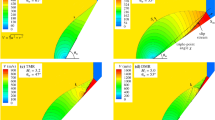Abstract. In this paper, we consider the phenomenon of unsteady Mach reflection generated by a plane shock wave advancing over a straight wedge surface, with particular attention to the deviation of the flow field from the self-similar nature. We examine the observed change in angle between incident and reflected shocks, which is in contrast to the fact that the angle should remain constant with time in a self-similar flow. The effect of the boundary layer behind the advancing shock wave over the surface of the wedge is considered to cause this, and boundary layer theory is utilized to estimate the thickness of the layer. It is found that the thickness increases as \(\sqrt{t}\) to the time t compared with t by the overall expansion in the self-similar flow. Assuming that the thicker boundary layer is effectively equivalent to a change in wedge angle, the effect of the boundary layer on the flow field should be less in later stages with larger t values in accordance with the observation above.
Similar content being viewed by others
Author information
Authors and Affiliations
Additional information
Received 6 March 2000 / Accepted 23 April 2001
Rights and permissions
About this article
Cite this article
Adachi, T., Sakurai, A. & Kobayashi, S. Effect of boundary layer on Mach reflection over a wedge surface. Shock Waves 11, 271–278 (2002). https://doi.org/10.1007/s001930100104
Issue Date:
DOI: https://doi.org/10.1007/s001930100104



